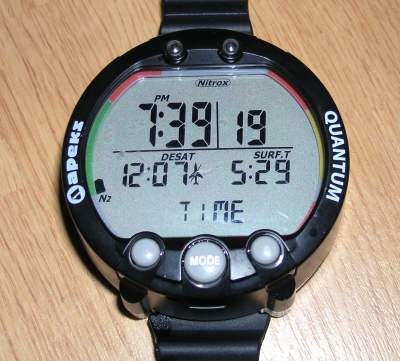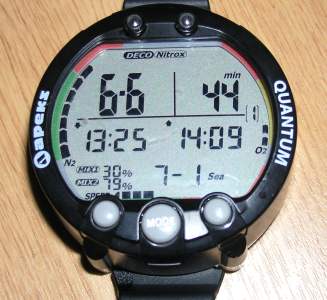For some time, I've been meaning to get myself a new dive computer. I have been using a Cochran Commander for several years with no real problems, but I really wanted a backup. Preferably one that could do 2 mixes of nitrox and has a gauge mode. Initially, I thought the Suunto Vytec looked promising, but having dived most of 2003 with a buddy who used a Vyper, I decided it was just too conservative for me.
Then I saw the new Apeks Quantum computer advertised. These computers are apparently made by Seiko and are also sold by Dive Rite as the Nitek Duo. The Apeks version was certainly competitively priced. I had no problem picking up one for £199 off the net.
 The unit itself is quite small and has two metal contacts and three push buttons. The metal
contacts are only used to detect immersion and presumably for the computer interface when it
becomes available. All configuration is done using the buttons, and the interface is easy to
use and intuitive. There's no beeping, no licking of fingers and no messing around with a coin
which you get with other dive computers.
The unit itself is quite small and has two metal contacts and three push buttons. The metal
contacts are only used to detect immersion and presumably for the computer interface when it
becomes available. All configuration is done using the buttons, and the interface is easy to
use and intuitive. There's no beeping, no licking of fingers and no messing around with a coin
which you get with other dive computers.
The computer is powered by a standard Lithium battery and is user replaceable. You just need a coin to undo the back. Also on the back is a reset button. Pressing this clears all the information in the computer including nitrogen loading. Whilst this is obviously to abuse, it will be handy for dive shop owners who rent out computers and for anyone who lends their computer to a friend and then wants to use it themselves.
The user can set either 1 or 2 nitrox mixes. Personally I prefer computers which stay set with whatever mix I put in. The Quantum resets itself at midnight every night, so correcting the system clock is a good idea when holidaying in other time zones. Mix 1 has a maximum pO2 of 1.4 bar. Mix 2 has a maximum pO2 of 1.6 bar. If you exceed these you get an alarm, and the computer won't let you make a gas switch underwater if it means you exceed these limits.
The computer also has a plan mode and gives the following times for no-deco diving on air:
| Depth | No stop time |
|---|---|
| 9m | 200 |
| 12m | 104 |
| 15m | 66 |
| 18m | 47 |
| 21m | 35 |
| 24m | 25 |
| 27m | 19 |
| 30m | 16 |
| 33m | 14 |
| 36m | 11 |
| 39m | 9 |
| 42m | 8 |
| 45m | 7 |
| 48m | 7 |
There is also a gauge mode, which is apparently good to 199m, which I think is deep enough for my purposes.
My first test dive was on the Kyarra. I had the Apeks on one wrist and my Cochran Commander Nitrox, set to 2% conservatism, on the other. The only reason I was doing the dive was that I had a 37% nitrox fill in my tanks, despite having asked for 30% in the shop. They'd labelled them 32%, which only goes to prove that you should always personally test your gas before diving it.
I set both Mix 1 and Mix 2 to 37%. This was a slightly hot mix for the Kyarra, which on that tide was at 29m, so it was no surprise when the Apeks started beeping as I exceeded a pO2 of 1.4 bar. Pressing button 1 for 5 seconds resulted in switching to Mix 2. Although this was also set to 37%, the allowed pO2 is 1.6 bar, so it got rid of the alarm and the computer was happy again. Personally, I wouldn't exceed a pO2 of 1.5 bar on the bottom. I only use 1.6 bar when at rest on deco stops, which is line with the recommendations of the agencies I did my nitrox courses with. It would be nice to be able to change the alarm level to 1.5 bar, but it doesn't appear to be an option.
During the dive, the display was easy to read. The current mixes, pO2, depth, and dive time are shown. There is a bar graph on the left which shows nitrogen absorption and one on the right for O2. Even with my slightly elevated pO2, I didn't exceed 2 bars on the O2 graph. At the bottom is an ascent rate graph, which works on a variable ascent rate. Pressing button 2 takes you to another screen which displays the maximum depth, dive time again and the temperature to one decimal point.
The dive was called slightly short because my buddy had problems with his rebreather, so we were well inside the no-decompression limits. During the dive, the Quantum consistently gave me 5 minutes less no-deco time than the Cochran. As we ascended to 6m, the Quantum showed the message STOP and started to count down a 3 minute safety stop in minutes and seconds. You can skip it if you want, with no penalty, but safety stops are a very good idea. The Quantum only counts down whilst at 6m or shallower. Drop down to 6.1m, and the countdown stops, though it doesn't reset back to 3 minutes. I thought this was a bit fussy as many UK divers do their shallowest stop at 6m.
The next dives I made with the computer were deeper, to about 35m, typically using 30%. On these dives, there was less of a difference compared to the Cochran. The Apeks usually went into deco when the Cochran was showing 2 minutes of no stop left. Short slack times on the wrecks meant that I stuck to 10 minutes deco. The two minute difference seemed to stay the same with the Apeks showing 9 mins at 3m and the Cochran showing 7 minutes. My ascent rates were slow and it was good to see that the Apeks would clear stops before the actual stop depth. On raw Buhlmann tables, it takes 1.3 minutes to clear 1 minute 3m stop at an actual depth of 6m. The Apeks seemed to follow this using as it does, an algorithm described as "Modified Swiss". Other computers on the market can take as long as 2 minutes at 6m to clear a 1 minute 3m stop. Many UK diver don't like 3m stops because of the effects of surface swell and surge at such shallow depths.
When the computer goes into decompression mode, it displays the word DECO, so there's no confusing the safety stop and mandatory deco stops. It then displays the stop depth, time at that depth and total ascent time. Unfortunately, this moves the dive time off the display. It's still available by pressing button 2, but it's a bit of a pain. I like to see the dive time so that I can add deep stops into my ascent easily. That said, if I'm doing a deco dive, I have another source of dive time readily available anyway.
One of the best features is the log. Just about everything about the dive is stored.
 | 
|
So my overall impressions are good. At £199 for a 2 mix dive computer, it's a bargain. It's not perfect. I'd really like to be able to set the pO2 alarm level and having the dive time on the second screen only when in deco mode is not ideal. It seems to be a bit conservative on shallower dives, but deeper than 30m, it's not much different to my other computers. It'll be interesting to see how it performs when doing several multi-level dives a day.
I originally wrote this review over 6 years ago. I'm still using the computer, though the first one developed a fault with the buttons after 18 months. I sent it back to Apeks and got a new model two days later. I've since used that for over 5 years with few problems. The only issue I've had with it is when the battery gets low. It will start beeping and the depth will change wildy when you're actually stationary. However, a new battery solves that and it's a common problem. Battery meters just aren't reliable, especially as the voltage will drop as soon as you get into cold water.
